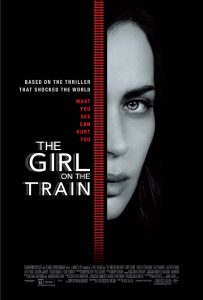People are calling The Girl on the Train a sexy thriller, but it’s not. It’s a mystery, rather than a thriller, and while there’s enough sex onscreen to make quota, the sex is desperate and joyless and generally discomfiting.
Rachel (Emily Blunt) is a morbidly depressed alcoholic who rides a Metro-North train to and from Manhattan every day. She always sits on the same side of the same car in order to get a glimpse of her old suburban neighborhood, where she was happily married to Tom (Justin Theroux) until her inability to have children ruined everything. She started drinking, becoming (apparently) volatile and unstable. Tom then left her for Anna (Rebecca Ferguson), who promptly had a baby, which only tightened Rachel’s downward spiral. Now she drinks copious amounts of vodka from a sport water bottle, to stay drunk all day, and constructs a soothing narrative of happiness around Megan (Haley Bennett), whom she sees every day from the train and is—or at least seems to be, from Rachel’s precarious point of view—blissfully in love with her husband, Scott (Luke Evans). Megan, not coincidentally, bears a resemblance to Anna.
Rachel’s depression, self-loathing, and tendency to get blackout drunk make her an unreliable witness, to say the least, and her unreliability is key to the plot. When Megan goes missing and then turns up dead, Rachel becomes a suspect in her disappearance, and neither she nor we can be sure she’s innocent. The mystery consists mostly in whether Rachel will be able to reconstruct enough of her memory to get at the truth. But the movie expends too much energy on establishing her unreliability. Strange to say of a project called The Girl on the Train, but there are too many scenes of her on the train, staring hopelessly out the window, drinking from her alcoholic’s economy-sized version of a sippy cup. Director Tate Taylor makes the sound decision to close in on Rachel with a slightly shaky camera when she’s onscreen, until her face fills the frame. (Blunt’s face is a bit puffy here, with a touch of gin-blossom pink on her nose and cheeks. She looks like someone in the early stages of killing herself with drink.) Each of these jittery close-ups is a visual cue to her instability and claustral subjectivity, and their cumulative effect is subtle but strong and makes all of her moping, while telling us in voiceover how unhappy she is, superfluous. Moreover, the insistence on Rachel’s anguish infects the rest of the movie. Everybody in The Girl on the Train is miserable. Nobody laughs. Nobody even smiles. So much grief with not one tittle or jot of joy to leaven it is unconvincing because untrue—untrue to life, but also untrue to the story. The narrative jumps around chronologically in a way that seems to invite the viewer, along with Rachel, to puzzle out what really happened, but the sameness of mood makes past and present hard to differentiate, encouraging confusion on the viewer’s part, and making the development of the plot feel contrived rather than inevitable.
I can imagine the Academy of Motion Picture Arts and Sciences nominating Emily Blunt for Best Actress, and while I don’t believe she was working with good enough writing to merit such a nod, she deserves some kind of recognition for her stamina. Having to plumb an invariable sorrow for however many weeks the shoot took couldn’t have been easy.
The Girl on the Train isn’t exactly a failure. It has something to say about the idea of motherhood (as opposed to the fact of motherhood, since children play no meaningful part in this story) and the tyranny of that idea in the lives of white, middleclass women. It’s smarter and less preposterous than its thematic cousin, Gone Girl, but it’s also less riveting as entertainment.


